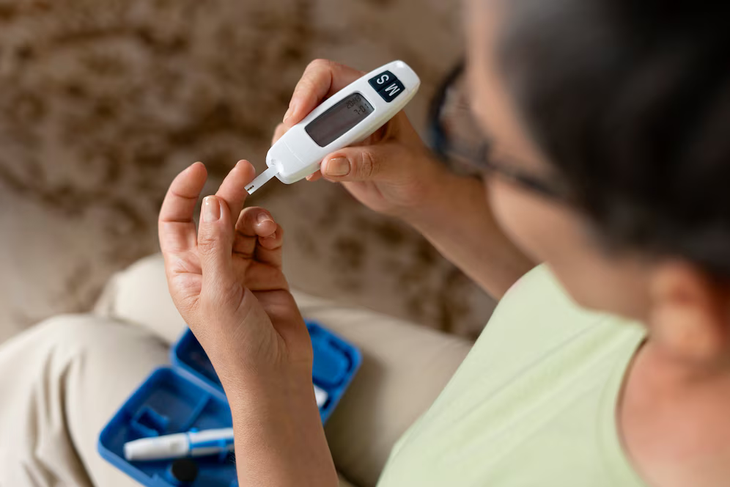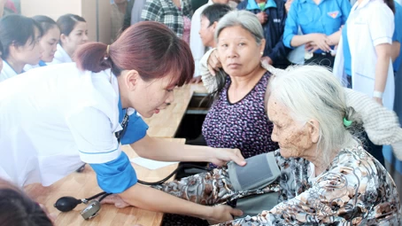
Hot weather not only increases the risk of dehydration but also makes blood sugar control more unpredictable for people with diabetes - Photo: Freepik
Both hyperglycemia and hypoglycemia can occur in people with diabetes, and can be difficult to recognize because the symptoms can be easily confused with weather effects.
How does blood sugar change when the temperature is high?
Hyperglycemia
Moderate to high-intensity exercise combined with hot weather causes people with diabetes to sweat a lot, leading to dehydration, which causes blood sugar levels to rise.
Diabetics, both type 1 and type 2, feel hotter than normal people because complications of the disease such as blood vessel and nerve damage affect the function of sweat glands, making the body unable to cool effectively.
Hypoglycemia
Hot weather can increase the risk of hypoglycemia for people taking blood sugar lowering medications such as insulin. Because the body's metabolism increases in hot weather and the absorption of insulin also increases, the risk of hypoglycemia is increased.
Hypoglycemia is also harder to detect in hot weather. Therefore, it is important to pay attention to the symptoms of hypoglycemia, such as sweating and fatigue due to high temperatures, which can also be signs of hypoglycemia.
Dehydration
People with diabetes often become dehydrated faster than others. If they do not drink enough water, their blood sugar levels will increase, causing them to urinate more, causing more dehydration.
Secrets to keeping blood sugar levels stable during hot weather
Protect yourself in hot weather with jackets, hats, and sunscreen. People with diabetes need to be even more careful.
Check your blood sugar regularly: especially before, during, and after exercise or before taking insulin.
Drink enough water: Drinking enough water in hot weather helps prevent dehydration and better control blood sugar.
Watch for symptoms of hypoglycemia: if the patient is sweating and tired, check blood sugar immediately. Always carry candy or soft drinks in case of symptoms of hypoglycemia.
Store medications, insulin, and blood glucose testing kits in a cool place: heat will distort the results of blood glucose meters and test strips, and also increase the effects of insulin and hypoglycemic drugs. Therefore, it is necessary to test blood glucose and store medications, insulin, and testing kits in a cool place and away from sunlight.
Foot care: People with diabetes often have reduced or lost sensation in their feet. Therefore, they should not walk barefoot on hot ground and should always apply sunscreen to their body.
When a patient has symptoms of headache, dizziness, nausea and vomiting, fatigue, muscle cramps, abdominal pain and pale skin, these may be symptoms of high blood sugar or heat stroke. Therefore, it is necessary to check blood sugar immediately and treat heat stroke immediately.
Dr. Tran Thi Kim Thanh is currently Head of Department of Internal Medicine Cardiology IV - Department of Cardiology and Metabolism - Tam Duc Heart Hospital. With many years of experience in the field of cardiovascular and endocrinology, Dr. Thanh specializes in echocardiography and cardiovascular rehabilitation.
Source: https://tuoitre.vn/nang-nong-hiem-hoa-tham-lang-voi-nguoi-benh-tieu-duong-20250503093814864.htm


![[Photo] 12th grade students say goodbye at the closing ceremony, preparing to embark on a new journey](https://vphoto.vietnam.vn/thumb/1200x675/vietnam/resource/IMAGE/2025/5/28/42ac3d300d214e7b8db4a03feeed3f6a)


![[Photo] General Secretary To Lam works with the Central Policy and Strategy Committee](https://vphoto.vietnam.vn/thumb/1200x675/vietnam/resource/IMAGE/2025/5/28/7b31a656d8a148d4b7e7ca66463a6894)
![[Photo] Prime Minister Pham Minh Chinh receives a bipartisan delegation of US House of Representatives](https://vphoto.vietnam.vn/thumb/1200x675/vietnam/resource/IMAGE/2025/5/28/468e61546b664d3f98dc75f6a3c2c880)
![[Photo] Vietnamese and Hungarian leaders attend the opening of the exhibition by photographer Bozoky Dezso](https://vphoto.vietnam.vn/thumb/1200x675/vietnam/resource/IMAGE/2025/5/28/b478be84f13042aebc74e077c4756e4b)


















































































Comment (0)